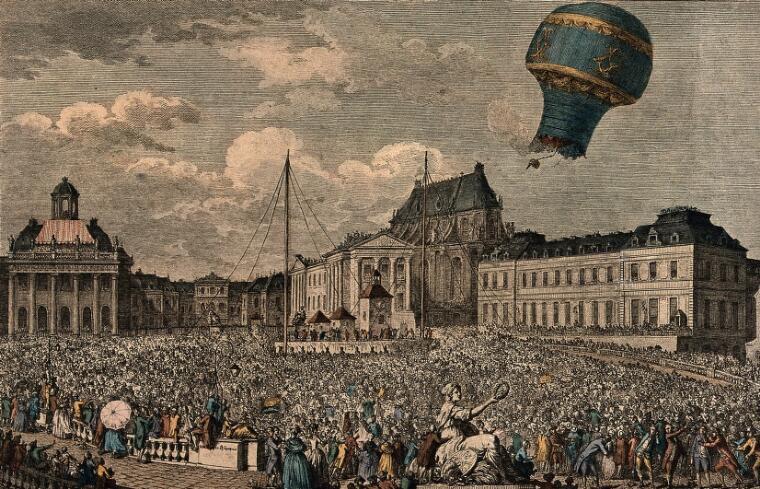- About MAA
- Membership
- MAA Publications
- Periodicals
- Blogs
- MAA Book Series
- MAA Press (an imprint of the AMS)
- MAA Notes
- MAA Reviews
- Mathematical Communication
- Information for Libraries
- Author Resources
- Advertise with MAA
- Meetings
- Competitions
- Programs
- Communities
- MAA Sections
- SIGMAA
- MAA Connect
- Students
- MAA Awards
- Awards Booklets
- Writing Awards
- Teaching Awards
- Service Awards
- Research Awards
- Lecture Awards
- Putnam Competition Individual and Team Winners
- D. E. Shaw Group AMC 8 Awards & Certificates
- Maryam Mirzakhani AMC 10 A Awards & Certificates
- Two Sigma AMC 10 B Awards & Certificates
- Jane Street AMC 12 A Awards & Certificates
- Akamai AMC 12 B Awards & Certificates
- High School Teachers
- News
You are here
Things Certain and Uncertain
An old idiom, employed by many writers over the years and popularly attributed to American polymath Benjamin Franklin, claims that nothing is certain except death and taxes. Franklin was not the first to use this phrase: versions of it appear in Daniel Defoe's 1726 book The Political History of the Devil [Defoe 1726, p. 269] and Christopher Bullock's 1716 play, The Cobler of Preston [Bullock 1716]. As it happened, Franklin came to use this idiom in a letter to his friend, French physicist Jean-Baptiste Le Roy, on 13 November 1789:
Our new Constitution is now established, and has an appearance that promises permanency; but in this world nothing can be said to be certain except death and taxes! [Franklin 1818, p. 259]
Six years prior, in 1783, two particular events occurred, one undeniably certain and one profoundly uncertain. On 19 September 1783, Le Roy himself was among the many witnesses present as a sheep, a duck, and a rooster became the first passengers aboard a hot air balloon constructed by the brothers Joseph-Michel and Jacques-Étienne Montgolfier, who had spent the past several months experimenting with their flying device. The balloon, dubbed the Aérostat Réveillon after wallpaper-maker Jean-Baptiste Réveillon, lifted off the grounds of royal palace at Versailles and flew for about 8-10 minutes and to an altitude of 1,500 feet over a crowd that included King Louis XVI and Queen Marie Antoinette [Kotar and Gessler 2003, p. 12].

Figure 1. The Aérostat Réveillon lifts off from the grounds of the
Palace of Versailles on 19 September 1783. The Wellcome Collection.
The night before this remarkable flight, famed Swiss mathematician Leonhard Euler succumbed to a brain hemorrhage at his home in St. Petersburg, Russia. The death of such a luminary as Euler was, if not unexpected, a profound loss for the mathematical community. Over his 56 year career, Euler contributed to such disparate fields as astronomy, number theory, mechanics, calculus, graph theory, and music theory. His prowess at mental calculation was widely known. In one amusing anecdote, related to us by Nicolas Fuss, Euler calculated the first six powers of all numbers under 20 when unable to sleep one night, and was able to recite them all from memory a few days later [Fuss 1783, p. 208].
In the Marquis de Condorcet's eulogy, Euler's death occurred suddenly in the bucolic setting of his St. Petersburg estate:
He had his grandson come and play with him and took a few cups of tea, when all of a sudden the pipe that he was smoking slipped from his hand and he ceased to calculate and live [Condorcet 1783, p. 67, translated by John S. D. Glaus].
Euler's influence would continue long after his death, with many of his works not published until 1862. All told, he wrote over 800 papers in mathematics and science, as well as some 30 books. His work revolutionized the mathematical sciences. However, Euler's work had a more specific and immediate impact after his death. Just before reporting the death of Euler in his eulogy, Condorcet wrote on Euler's particular interest in the weeks leading up to his death:
On [18] September 1783, after having enjoyed some calculations on his blackboard concerning the laws of ascending motion for aerostatic machines for which the recent discovery was the rage of Europe, he dined with Mr. Lexell and his family, spoke of Herschel’s planet and the mathematics concerning its orbit [Condorcet 1783, pp. 67–68, translated by John S. D. Glaus].
As we see here, Euler was engaged in the study of the Montgolfier brothers' novel “aerostatic machines” on the very day of his death. The calculations of the balloons’ motion remained on the blackboard even as Euler himself “ceased to calculate and live.” The following year, a short piece appeared in the Memoires of the Paris Academy, titled “Calculs sur les Ballons aérostatiques faits par feu M. Léonard Euler, tels qu’on les a trouvés sur son ardoise, après sa mort arrivée le 7 Septembre 1783” (“Calculations on aerostatic balloons made by the late Mr. Leonhard Euler, as they were found on his blackboard, after his death on 7 September 1783”) [Euler 1784, numbered E579]. Euler’s son, Johann-Albrecht, had forwarded a copy of these calculations to the Paris Academy, thus preserving the work in the public record.
In this article, we examine Euler’s valedictory and consider what conclusions can be drawn from it. We begin with some history of the study of balloon flights at the time, as context for his interest in the mechanics of balloon flight. Following our analysis of Euler’s calculation, we also present a classroom capsule with suggestions for how it can be used in a contemporary differential equations or physics course.
Michael P. Saclolo (St. Edward’s University) and Erik R. Tou (University of Washington Tacoma), "Things Certain and Uncertain," Convergence (May 2023), DOI:10.4169/20230522




